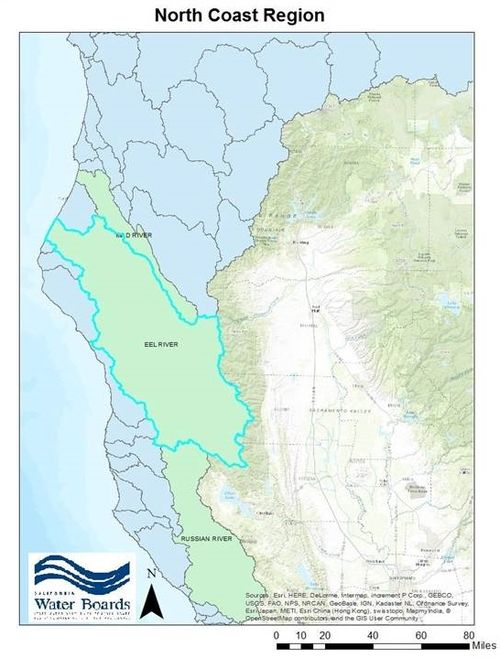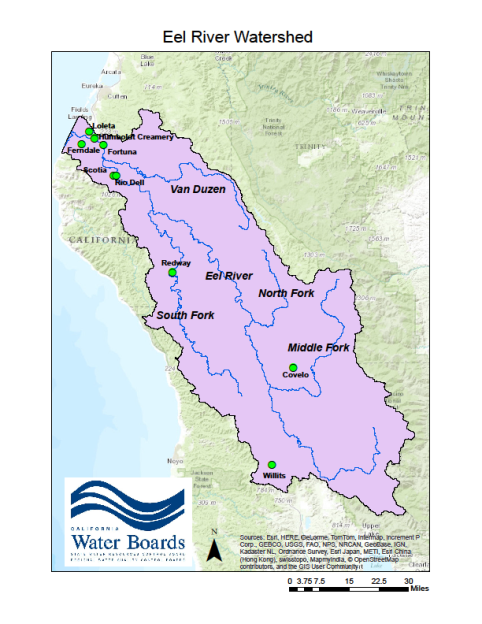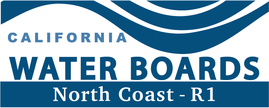Eel River Seasonal Discharge Prohibition
Project Description
The Regional Water Board has approved the 2014 Triennial Review and adopted a list of priority planning projects. The Eel River Seasonal Discharge Prohibition project is priority project #4. Currently, summertime point source discharge of waste is prohibited in the Eel River from May 15 through September 30 each year. This seasonal prohibition contained in Implementation Plans Section 4, was first established in the original Basin Plan as adopted in 1975 and was based at least in part on the limited wastewater treatment capabilities of the time. Compliance with the prohibition protects instream beneficial uses by minimizing pollutant discharges to surface water through the use of storage, land disposal, or reuse (recycling) of treated effluent.
This project considers the growing appreciation for the relationship between water quality and water quantity by evaluating the potential benefits to beneficial uses that could be derived from flow augmentation during the low flow season, especially as a response to the ecological pressures associated with climate change. It also considers the improvements in wastewater treatment technology and effluent quality, as compared to that of the 1970s when the prohibition was first designed.
Embedded in the project is an analysis by which the benefits of flow augmentation are weighed against the potential risks associated with effluent discharge. The project’s outcome must ensure water quality protection, but may offer mechanisms by which to promote other water quality factors important to a healthy watershed. The development of prohibition exemption criteria may provide an effective way of balancing the risks and benefits. Development of this Triennial Review project will consider the interests of multiple stakeholders, including resources agencies, municipal service entities, regulatory agencies, and the public.
Planning staff will assess existing conditions in the Eel River watershed, the existing regulatory framework that guides point source waste treatment and discharge permitting, and the risks and benefits of flow augmentation using highly treated effluent. Preliminary research suggests that planning staff also evaluate the merit of beneficial use enhancement opportunities beyond flow augmentation.
In addition to stakeholder outreach and collaboration that will be conducted by planning staff, evolution of this project may include:
- Policy review and assessment
- Data collection and gap analysis
- Additional monitoring
- Water quality modeling
- Beneficial use assessment
- Criteria for prohibition exemption
Background
The North Coast Regional Water Quality Control Board Basin Plan (Basin Plan) specifies numerous objectives for inland surface waters, enclosed bays, and estuaries. These objectives are used to protect the beneficial uses of state waters. The objectives are achieved, protected, and maintained through various programs of implementation. A cornerstone of water quality implementation in the North Coast is the prohibition on point source discharges to all surface waters in the region, except the Mad, Eel, and Russian rivers and their tributaries. In these three waters, a seasonal prohibition applies to point sources, which restricts discharge to the typical wet weather season: October 1 through May 14, including discharge rate limitations.
Population growth, climate change and drought are increasing pressure on North Coast water resources. Various land use practices and changes in rainfall patterns have altered local hydrology in the Eel River watershed, resulting in more run off and less infiltration of precipitation into soil and groundwater thereby reducing the availability of cold water during the low flow months of the summer. As a result, aquatic organisms and salmonids in particular are often struggling to survive in warm shallow waters. Low flows coupled with warm temperatures and increased water demands occurring during dry summer months exacerbate the impacts on instream beneficial uses of low dissolved oxygen levels, biostimulatory affects, and loss of habitat. These challenges represent an opportunity to consider a regulatory framework that promotes improved treatment of wastewater effluent to expand the possible reuse options.
Post 1975 developments in technology have resulted in wastewater treatment breakthroughs for reclamation and water reuse. Technology is now available, and in some cases in place, to remove nutrients, colloidal and suspended solids, low level organic compounds, and provide greater assurances for removal of human pathogens, and other pollutants of concern from point source discharges. Based upon contemporary conditions and future conditions under changed climate scenarios, summertime augmentation of surface water flows with highly treated wastewater may have potential to provide environmental benefit in the Eel River and its tributaries, which would not exist in its absence. Of particular interest to the Regional Water Board is the potential to improve support for existing beneficial uses, such as Cold Freshwater Habitat, Spawning, Reproduction, and/or Early Development, Migration of Aquatic Organisms, Rare, Threatened, or Endangered Species, and Water Contact and Non-Contact Recreation.
The Eel River Seasonal Discharge Prohibition project is currently in the initial stages of development. In order for the Regional Water Board to consider a proposed amendment to the Basin Plan that would allow a process for point source summertime discharges in the Eel River, Regional Water Board staff must first evaluate the risks and benefits associated with an exemption to the existing prohibition and the criteria necessary to reduce identified risks. Staff will be soliciting stakeholder input regarding potentially affected parties and environmental concerns.
The next steps will be to develop and fully flesh out a scope of work and study design plan to guide the project. We will be working with stakeholders throughout this process to ensure that we consider the diversity and breadth of issues in the Eel River Watershed. We anticipate additional monitoring and data collection will be needed over the course of the next 1-2 years to provide the lines of evidence we will need to reach sound conclusions on these issues. We look forward to a project scoping kick-off meeting once available information and data gaps have been identified and the range of issues has been refined. The project schedule is currently under development. However, the following provides a tentative schedule for major project milestones:
Milestone |
Tentative Timeframe |
|---|---|
2017 |
|
Project Scoping |
2017 |
Supplemental Monitoring |
2017-18 |
Technical Advisory Team |
2018-19 |
Peer Review Staff Report |
2019 |
CEQA Scoping |
2019 |
Regional Water Board Consideration |
2020 |
This web page will be updated periodically to present opportunities for input and participation, host public notices, fact sheets and serve as a repository for other factual information such as reports, presentations of research, or information as developed throughout the life of the project. To receive updates related to this project, please sign up for the lyris list using the link below.
Three Watersheds Subject to the Seasonal Discharge Prohibition

Existing Permitted Point Source Discharges in the Eel River Watershed

Contact Information
For information, comments, or questions concerning this basin planning project please contact Lisa Bernard, Sanitary Engineering Associate at 707-576-2677 or lisa.bernard@waterboards.ca.gov.
Mailing Lists
We encourage users interested in this basin planning project and other basin planning issues to subscribe to the Basin Planning lyris email list .Resources
- Basin Plan Start
- Basin Plan Documents
- Dissolved Oxygen Amendment
- Editorial Amendments
to Basin Plan - Groundwater Protection
Policy - Mixing Zone Policy
- OWTS Policy
- Restoration Policy
- Smith River ONRW Designation
- Stream and Wetlands System Protection Policy
- Temperature Amendment
- Triennial Review
- Water Quality Objectives
(Page last updated 5/21/19)
Water is a precious resource in California, and maintaining its quality is of utmost importance to safeguard the health of the public and the environment.
Statewide Campaigns
EPA Water Sense
File an Environmental Complaint
Save Our Water
Flex Alert
Register to Vote



